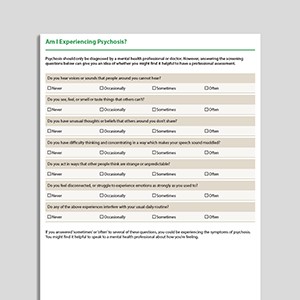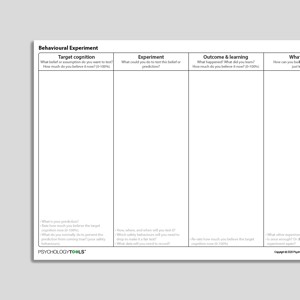Psychosis
Psychosis is a set of symptoms that includes hallucinations and delusions. Hallucinations are sensations that are not real, such as seeing or hearing things that aren’t there. The experience of hearing voices is one common type of hallucination, but hallucinations can be experienced in any of our senses (sight, sound, smell, touch, or taste). Delusions are strong beliefs that are not true. Common delusions include the belief that you are being followed or watched, or the belief that you have extraordinary abilities. Although traditional approaches to psychosis have been biomedical there is increasing recognition of the utility of psychological approaches. Psychological approaches to psychosis might attempt to gain an understanding of: how predisposing factors may have led to the onset of symptoms; how symptoms are understood; and how psychotic experiences are perpetuated.
Managing Bipolar Disorder: Therapist Guide
Managing Bipolar Disorder: Therapist Guide
Cognitive Distortions – Unhelpful Thinking Styles (Common)
Cognitive Distortions – Unhelpful Thinking Styles (Common)
Cognitive Distortions – Unhelpful Thinking Styles (Extended)
Cognitive Distortions – Unhelpful Thinking Styles (Extended)
Everyday 'Unusual' Experiences
Everyday 'Unusual' Experiences
What Keeps Psychosis Going?
What Keeps Psychosis Going?
What Is Compassion Focused Therapy (CFT)?
What Is Compassion Focused Therapy (CFT)?
Unhelpful Thinking Styles (Archived)
Unhelpful Thinking Styles (Archived)
Behavioral Experiment (Portrait Format)
Behavioral Experiment (Portrait Format)
Links to external resources
Psychology Tools makes every effort to check external links and review their content. However, we are not responsible for the quality or content of external links and cannot guarantee that these links will work all of the time.
Assessment
- The Subjective Experiences Of Psychosis Scale | Psychosis Research Unit
- Beliefs About Voices Questionnaire – Revised (BAVQ-R) | Chadwick et al | 2000
Exercises
- Self-help guide to dialoguing with voices – 1st version | Rufus May, Elisabeth Svanholmer | 2017
Guides and workbooks
- Psychosis And Substance Use | NDARC: Mills, Marel, Baker, Teesson, Dore, Kay-Lambkin, Manns, Trimingham | 2011
- Self-help guide to talking with voices: ideas for people who hear voices and want to try engaging in dialogue with them (2nd edition) | Rufus May, Elisabeth Svanholmer | 2019
- Self-help guide to talking with voices: ideas for people who hear voices and want to try engaging in dialogue with them – 2nd version | Rufus May, Elisabeth Svanholmer | 2019
Information Handouts
- Hearing Voices Or Other Things That May Not Be There | Psychosis Research Unit
- Drugs and alcohol
- Stress management 2
- Stress management 1
- Social support
- Relapse prevention planning
- Psychosocial treatments
- Persistent symptoms
- Medication
- Lifestyles
- Early intervention
- What is psychosis brochure
- Causes of psychosis
- What is psychosis?
- Talking therapies for voices
- Talking about voices: suggestions for supporters
- Talking about voices: suggestions for voice-hearers
- Coping with voices
- Why do people hear voices?
- Hearing voices: A spectrum of experience | Understanding Voices (UV)
- What is hearing voices?
Presentations
- The Garety et al model of CBT for psychosis | Dr Anna Rowe
- CBT for psychosis in practice | David Kingdon
- Assessment in early psychosis | Sean Halpin
Treatment Guide
- Cognitive Behavioral Therapy for Psychosis (CBTp): an introductory manual for clinicians | Yulia Landa
- Social Skills Training for Severe Mental Disorders | Patrick Kingsep, Paual Nathan
- Social Anxiety in Schizophrenia: A Cognitive Behavioural Group Therapy Programme | Patrick Kingsep, Paula Nathan
- Cognitive Behaviour Therapy for Psychotic Symptoms: A Therapists Manual | Laura Smith, Paula Nathan, Uta Juniper, Patrick Kingsep, Louella Lim | 2003
- A manualised treatment protocol to guide delivery of evidence-based cognitive therapy for people with distressing psychosis | Morrison | 2017
- Understanding psychosis and schizophrenia | British Psychological Society, Division of Clinical Psychology | 2017
- NICE Guidelines For Psychosis And Schizophrenia | NICE | 2014
Video
- CBTp – Identifying goals using a Q sort task | Psychosis Research Unit youtube
- CBTp – Utilising attentional strategies | Psychosis Research Unit youtube
- CBTp – Discussing sleep hygiene | Psychosis Research Unit youtube
- CBTp – Reducing social isolation | Psychosis Research Unit youtube
- CBTp – Reviewing a survey for appearance | Psychosis Research Unit youtube
- CBTp – Planning a survey (appearance) | Psychosis Research Unit youtube
- CBTp – In-session behavioral experiment | Psychosis Research Unit youtube
- CBTp – Setting up a behavioral experiment | Psychosis Research Unit youtube
- CBTp – Maintenance formulation of threatening voices | Psychosis Research Unit youtube
- CBTp – Normalising voices | Psychosis Research Unit youtube
- CBTp – Survey planning: intrusive thoughts | Psychosis Research Unit youtube
- CBTp – Advantages and disadvantages of paranoia | Psychosis Research Unit youtube
- CBTp – Assessment of thought broadcast and developing a maintenance formulation | Psychosis Research Unityoutube
- CBTp – Assessment of voice hearing and developing a maintenance formulation | Psychosis Research Unityoutube
- Compassion for voices: a tale of courage and hope | Charlie Heriot-Maitland, Kate Anderson youtube
- CBTp – Developing a longitudinal formulation | Psychosis Research Unit youtube
- Engaging with Voices | #1 Introducing ourselves, the videos, and our values youtube
- CBTp – Relapse prevention | Psychosis Research Unit youtube
- CBTp – Imagery modification | Psychosis Research Unit youtube
- CBTp – Schema change (using positive data logs) | Psychosis Research Unit youtube
- CBTp – Designing a behavioral experiment for thought broadcast | Psychosis Research Unit youtube
- CBTp – Developing a longitudinal formulation and planning a thought broadcast survey | Psychosis Research Unit youtube
- CBTp – Formulation of voice hearing and persecutory beliefs | Psychosis Research Unit youtube
- CBTp – Using worry postponement in response to voices | Psychosis Research Unit youtube
- CBTp – Exploring alternative explanations of voices | Psychosis Research Unit youtube
- CBTp – Using evidential analysis with voice hearing | Psychosis Research Unit youtube
- CBTp – Reviewing a survey for intrusive thoughts | Psychosis Research Unit youtube
Worksheets
- Checklist for good sleep
- Enjoyable activities
- Moving forward
- What causes psychosis?
- Persistent symptoms ratings
- Phases of psychosis
- Preventing weight gain
- Preventing relapse
- Social circles
- Stigma
- Stress management
- Telling others
- Treatment for psychosis
Recommended Reading
- Morrison, A. P. (2017). A manualised treatment protocol to guide delivery of evidence-based cognitive therapy for people with distressing psychosis: learning from clinical trials.Psychosis,9(3), 271-281.
- Morrison, A. P., & Barratt, S. (2009). What are the components of CBT for psychosis? A Delphi study.Schizophrenia Bulletin,36(1), 136-142.
- Morrison, A. P. (2000). The interpretation of intrusions in psychosis: an integrative cognitive approach to hallucinations and delusions. Behavioural and Cognitive Psychotherapy, 29, 257-276
What Is Psychosis?
Signs and Symptoms of Psychosis
Four main symptoms are associated with a psychotic episode:hallucinations
delusions
confused and disturbed thoughts
lack of insight and self-awareness
persecutory delusions—beliefs that one is being harmed, or that harm is impending;
grandiose delusions—an unshakable conviction that one possesses special powers, talents, knowledge, or abilities;
religious delusions—any delusions with a religious context.
Psychological Models and Theory of Psychosis
In Garety, Kuipers, Fowler, Freeman, and Bebbington’s (2001) cognitive model of positive symptoms of psychosis,biopsychosocial vulnerabilities and triggers combine to produce anomalous experiences (e.g., hearing a voice, a sense of being watched or followed). In psychosis these experiences are appraised as being external, resulting in positive symptoms of delusions and hallucinations. The appraisals an individual makes are influenced by prior beliefs and experiences and cognitive biases. The implications of the model are that changes in appraisals can be a powerful way of reducing distress in psychosis.Similarly, Morrison’s cognitive approach to understanding hallucinations and delusions (2001) argues that it is the misinterpretation of intrusive cognitive experiences that gives rise to distress and disability in psychosis. Morrison proposes that such misinterpretations are more likely to occur in individuals who have experienced traumatic events, and that if an intrusion has been misinterpreted once it is more likely to be misinterpreted if it occurs again. Morrison also proposes that counterproductive attempts to control unwanted experiences are also involved in the maintenance of psychosis.Evidence-Based Psychological Approaches for Working with Psychosis
Cognitive Behavioral Therapy for Psychosis (CBTp)
CBTp was originally developed as an individual treatment to reduce the distress associated with the symptoms of psychosis and to improve functioning. It has since been adapted as a group treatment. Brabban, Byrne, Longden, and Morrison (2016) propose that key elements of CBTp are:the collaborative development of a shared formulation to make sense of the origin and maintenance of psychotic symptoms and experiences;
normalization of psychotic experiences to decrease the stigma that is associated with psychosis;
acceptance of psychotic symptoms rather than attempting to alter their occurrence.
Individualized Resiliency Training (IRT)
IRT is an individual therapy designed for individuals experiencing a recent onset of psychosis (Penn et al, 2014). It draws upon a CBT background and consists of 14 modules covering topics including: education about psychosis; processing the psychotic episode; relapse prevention planning; developing resiliency; managing distress; coping with symptoms; improving social functioning; and addressing substance abuse.References
Brabban, A., Byrne, R., Longden, E., & Morrison, A. P. (2017). The importance of human relationships, ethics and recovery-orientated values in the delivery of CBT for people with psychosis. Psychosis, 9(2), 157–166.
Garety, P. A., Kuipers, E., Fowler, D., Freeman, D., & Bebbington, P. E. (2001). A cognitive model of the positive symptoms of psychosis. Psychological Medicine, 31(2), 189–195.
Morrison, A. P. (2001). The interpretation of intrusions in psychosis: an integrative cognitive approach to hallucinations and delusions. Behaviouraland Cognitive Psychotherapy, 29(3), 257–276.
Penn, D. L., Meyer, P. S., & Gottlieb, J. D., with Cather, C., Gingerich, S., Mueser, K. T., & Saade, S. (2014). Individual Resiliency Training (IRT). Bethesda, MD: National Institute of Mental Health. Retrieved from: https://www.nasmhpd.org/sites/default/files/IRT%20Complete%20Manual.pdf























